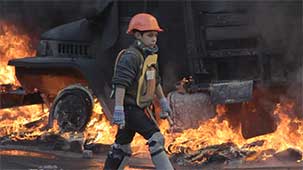Normally I’m suspicious of large groups of pale young people gathering together to subvert what they see as a repressive regime. Too often—in a North American context at least—such an insurgency is embodied by Oberlin college students boycotting the campus cafeteria, because they believe serving General Tso’s chicken is a type of cultural appropriation.
But in your case, there’s no doubting the righteousness of your cause or the courage you have shown in the face of real adversity. As with the recent Arab Spring (so starkly portrayed in the documentary The Square—a direct antecedent to Winter On Fire) this is the story of a populist uprising, largely propelled by politically engaged university students. Like the Tiananmen Square protests in 1989 or the Paris riots of 1968, these spontaneous, populist revolutions were in response to politically repressive (or otherwise unresponsive) regimes. All of these movements also began as small, student lead protests, but soon engaged a much broader coalition, from former soldiers, to union members and then schoolteachers, clergy and finally, just plain folks.
Both the Arab Spring and the Ukrainian uprising share one significant difference from both Tiananmen and the ’68 riots: they were largely facilitated by social media platforms like facebook and twitter. This made coordination of protests much more efficient as well as allowing for the widespread dissemination of video. This footage, often shot on mobile phones and mini-cams, was effective in demonstrating how disproportionate and brutal the government response was to what were initially peaceful protests, not to mention providing an enormous reservoir of primary material for the filmmakers.
Much of Winter on Fire revolves around this primary footage, which is interlaced with after the fact interviews with various participants—and these interviews are often shot in the same locations as the events they are describing. As a documentary Winter On Fire also makes clever use of graphics, specifically CGI maps that help paint a remarkably lucid picture of the geography in question. These maps are effective in helping describe what was a fluid set of circumstances—significant events would occur simultaneously, in complicated urban environments, and they are presented here in a way that was remarkably useful in understanding the larger narrative.
This documentary has an obvious bias and if someone is interested in a more complete understanding of the appallingly complicated clusterfuck that is European-Ukrainian-Russian relations, Winter on Fire is probably more useful as supplemental material than as a primary source. Still, most western viewers will likely side with the protesters. There is a rare kind of clarity to the issues in question, and some of the footage is both horrifying and inspiring: unarmed protesters, often carrying makeshift metal shields, being attacked by government snipers—yet still continuing to move forward. Kids of fourteen or fifteen dressed in makeshift armor, cooking pot helmets and sheets of metal used as ersatz bulletproof vests, all looking like they came from an illustrated version of Alice In Wonderland.
The interviews themselves are filled with real characters. There’s a Muslim cleric who looks like an accountant from Des Moines, an Orthodox priest who I’m not sure is old enough to shave, and a crusty, Andy Rooney-looking, left-leaning, Ukrainian academic who accuses the regime of having “unleashed a bacchanalia of dictatorship”. Winter on Fire is, by turns, an oddly giddy and sometimes tragically serious film. But the real centerpiece is you, the university and high school students that started the whole thing. Engaged, committed, well informed, and serious about your (and your children’s) future, you saw the promise of European economic and cultural membership, and chose, at great risk, and often with mortal consequence, to defy the governments attempts to link the Ukraine with Russia.
To see that kind of commitment is a substantial slap in the face to the surface level and self-interested squalling that often passes for political speech in North America. And it’s particularly damning in contrast with the kind of stupidities that seem to occupy a particular white, upper-middle-class segment of our universities. There is a lot to admire in this film, but nothing more so than kids like you who care enough about abstract concepts like democracy and free speech to risk life and limb in support of them.
Sincerely,

Tim






